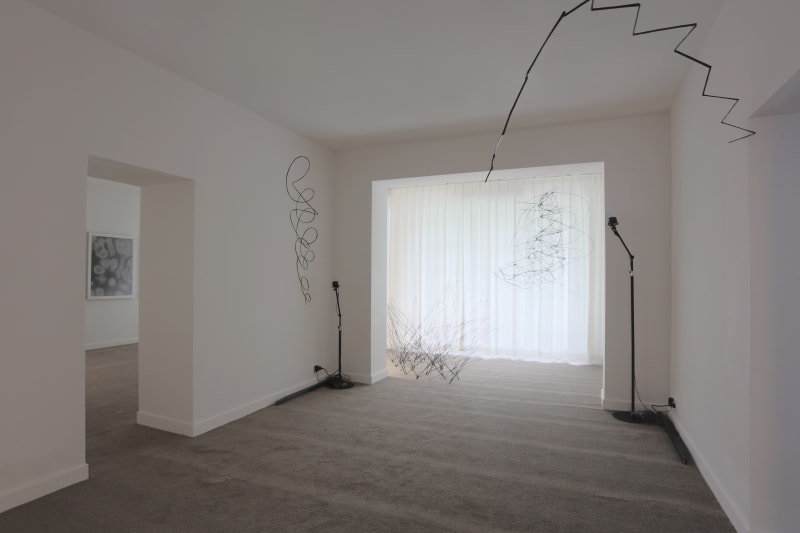I looked at Feng Chen's first solo exhibition many times at Capsule Shanghai in 2007, not only by myself but also invited friends and colleagues to see it with me. Among the works on view, Convulsion and The Darker Side of Light have left an imprint on all of our minds. What was being slapped in the video, the buttocks or the wrist? Once we've (or perhaps it was only me) confirmed the answer, everyone felt a perverse embarrassment. The flickering blinds were kind of scary, but it was not the intrusive kind of "shock".
Two years later, Feng Chen holds his second solo exhibition at Capsule Shanghai, "Moment by moment", as an extension of the previous one, where new works The Darker Side of Light: Moment and The Darker Side of Light: Shadow etc. are on view. Only from the titles of these artworks, it's not difficult to make a connection for these two exhibitions.
In contrast to his previous solo exhibition, "Moment by Moment" is formally more beautiful and accessible to those viewers who are less experienced with Feng Chen's works. In his own words, this exhibition is "friendlier", "I've tested out to deploy intense sensory stimulation in my previous exhibition, so my intention is not to "shock" you this time."
Song Min talks to Feng Chen
"VIEWER"
Song Min:
There is a strong continuity between these two solo exhibitions you've presented at Capsule Shanghai, and the latter seems to be a sequel of the former.
Feng Chen:
Indeed. The last exhibition focused on stimulating visual and audible senses. For instance, there was nudity in the video while the audio played repetitively without too many details. All of the works disclosed little information while their impact overloaded the viewers' sensory system - including the movements of the blinds that could have been shocking for some people. For this exhibition, my intention is not to "shock" or stimulate your sensors, instead, I want to make something calm with a lot of information that the viewers may find it difficult to put their finger on it.
Song Min:
Does "difficult to put one's finger on" imply obstacles that viewer would not immediately sense the notion behind the work of art?
Feng Chen:
Yes. This exhibition demands the viewer to take the time to sense, for which I've set up a gentle environment where I've put in the carpet, added curtains, and warm lighting - whereas the previous exhibition only used natural light. The video work in this exhibition does not have an audio component, neither is the sound piece complex. It aims to offer a healing texture instead of something destructive. At the same time, it may seem a bit bewildering, perhaps it's a bewildered healing. Since I've never tried this way of presenting an exhibition, I wanted to test out the viewer's response. Certainly, this plan has a lot to do with the temperament of the gallery space, which reminds one of a home, rather than a white cube, so I hope to make it a comfortable place.
Song Min:
It sounds like you pay attention to the viewer's reaction.
Feng Chen:
I would ask the gallery staff and my friend about their opinions of the exhibition. As much as the gallery's feedback was generally positive and encourage, my friends were frank and straightforward.
Although I am usually more selective in taking positive and negative feedback. Sometimes, I would purposefully avoid the effective advices. For instance, the more I am aware of the effective ways of presenting an exhibition the more efforts I put into avoiding them, because I don't want to fall into certain kind of convention. I want to test out new solutions, the ones that might not be mature, to see whether they would become possibilities. For a solo exhibition, I can control all the components, and fulfill all my self-imposed requirement. For me that's an opportunity to experiment, for the viewer and myself, I have no idea what the outcome would be, but let's try it out.
"TECHNOLOGY"
Song Min:
Your previous works primarily consisted of video works, and since your first solo, the medium of your works have diversified. Although some are still shown on a monitor but compare to your earlier works such as Hat, Killed in the Dream and Tofu, the narrative in the current works seems weaker, and as you said, "It's more difficult to put a finger on it."
Feng Chen:
I am making more installation works that are not intrinsically about narration. Often, the outcome of making video work is determined before it's even made, so the goal is made clear. And in the post-production phase, you can edit out the undesired sections, so its possibilities are also reduced. The medium is a pure expression - where the outcome can be perfect and effective. This is like completing a task, which is not fun.
For an installation, I can't predict the outcome because there are many unpredictable components. For me, that's the fun part. I am more fascinated with forms that I can't predict the outcome - it's the same with painting - it's not very interesting when it's didactic.
Song Min:
You would think that video works are easy to control?
Feng Chen:
It's easy to control the mood, every shot aims to do so - from long shot to closeups, fixed lens or moving - all of the languages with the camera lens have been studied. In the last exhibition, Untitled was an attempt to stay away from narrative through the lens and transforming the language of the lens to mechanical movement. I designed a program to pronounce the sound, the louder the sound the closer the lens approached, and vice versa. As the lens moved back and forth according to the volume of the sound, it eliminated human operation. This is considered a work between installation and video.
Song Min:
It seems high-tech.
Feng Chen:
It's quite simple. It's a simple conversion of an audio signal into a digital signal. It takes a 10 RMB Arduino, and 40 lines of code. It's not comparable to AI.
I would adopt many technological means into my practice, but my work does not involve technology. It seems I have been categorized as a "tech artist". While this kind of categorization may bring certain exhibition opportunities, I am uninterested in being limited to a specific genre. This is precisely what motivates me to experiment, other than installation, I would also experiment with painting and photography.
"POWER"
Song Min:
I've read in other interviews that you are skeptical of the power of control by the media, does your work try to intentionally create further misunderstanding?
Feng Chen:
The camera lens is inherently misleading, sometimes we think this device is too trustworthy. I want to expose this kind of disparity - the phenomenon in reality and the ones captured on camera. The restlessness in people's perception of such a difference is what I would like to express.
The camera lens also represents certain power, this kind of restlessness also addresses the power.
Song Min:
What are you referring to specifically with regards to power?
Feng Chen:
There are many, the greatest is perhaps the one on our living environment, the right to exist at this moment in time.
Song Min:
That's not apparent in this solo exhibition.
Feng Chen:
I didn't dare to do it.
Song Min:
Your earlier works exhibited strong political implications, especially Hat and Killed in the Dream seemed very different from your recent works.
Feng Chen:
All of my works are related to control. I would also like to make works that deliver straight forward expressions, but we don't have that kind of freedom. Sometimes, I am skeptical whether my works are what I want to express. Or am I doing so because of my restlessness and the inability to do so? Perhaps once we are free to express ourselves, that urge would disappear.
"TAOBAO"
Song Min:
What kind of transformation have you undergone since you began to make installations?
Feng Chen:
I would spend more time in my studio. It takes planning to make a video, usually the preparation would take a dozen days, then one day to shoot it. It's a process of long-term planning and short-term execution. On the contrary, an installation would take a dozen days to test, and is completed on the day of the exhibition opening, hence, it's a process of long-term planning and execution.
Song Min:
Many installation artists would adopt the model of an enterprise where he/she owns a factory and many workers are at his service. What is your current situation?
Feng Chen:
I can't afford to support that many people… neither are the installations I am making require such scale of production. I think our education system overemphasizes on our intellect but overlooks on cultivating our hands-on abilities. My residency in the Netherlands made me interested in becoming a hands-on artist (Feng Chen was enrolled in the two-years artist-in-residence program at the Rijksakademie). Without getting hands-on, one would never know if something is feasible, and for certain things I would only know how to make adjustments once I do it myself.
Song Min:
Were you the one who made the carbon fiber sculptures, It, He, She in this exhibition?
Feng Chen:
I would look for the material and product provider on Taobao, but these works were not made by the providers or factories. If you browse on Taobao frequent enough, it would affect your aesthetics. This is what I have suddenly realized. So, I try to use it less, even when I do, I try to browse on my computer rather than on a mobile app. The latter is driven by an attitude of entertainment, while the former is often associated with work.
Song Min:
Specifically, what kind of impact has Taobao had on your aesthetics?
Feng Chen:
My aesthetic inclinations were not this clean previously, it was a lot more unsophisticated. These carbon fiber sculptures have turned me into a "lighting maniac", as I would constantly adjusted the light to ascertain its even luminosity. This is similar to Taobao photography - immediately upon my graduation, I worked as a Taobao photographer with a few classmates to earn a living, so I know what kind of images the clients preferred - generally consists of a white background, clean and minimal image. The carbon fiber sculptures had an uneven surface once it was first finished, they had prickly thorns on the surface. So, I polished them somewhat, then I had to control myself. I am afraid of becoming a mechanical maniac, where everything is immaculate and beautiful.
Song Min:
Your exhibition is beautifully executed.
Feng Chen:
This has a lot to do with the exhibition space. Capsule Shanghai is quite sophisticated, so I would accommodate this general environment. My works would adjust to the exhibition context each time they are presented, for instance, The Darker Side of Light was shown in three different fashions at OCAT Shanghai, Jing'an International Sculpture Exhibition, and the Guangzhou Triennale.
Perhaps I have been somewhat greedy, I should have shown fewer works, and I should have put the sound piece in a separate room.
Song Min:
What are your views on Instagram-able exhibition? Would you wish your exhibition become one of them? (When I sat at the front door of your exhibition, many boys and girls who looked like online bloggers were taking selfies in the exhibition.)
Feng Chen:
Instagram-able exhibitions fulfill certain desires, I don't think that's a problem. But I don't think mine would become one because my works are not that appealing. Instead, my works would make people feel uncomfortable, in spite of being shown in a comfortable environment like this. The discomfort is what I would like to express. Whereas the comfortable things are what people like to post online, they make you feel that everything is perfect, like what's on Taobao.
Translated from Chinese by Fiona He



